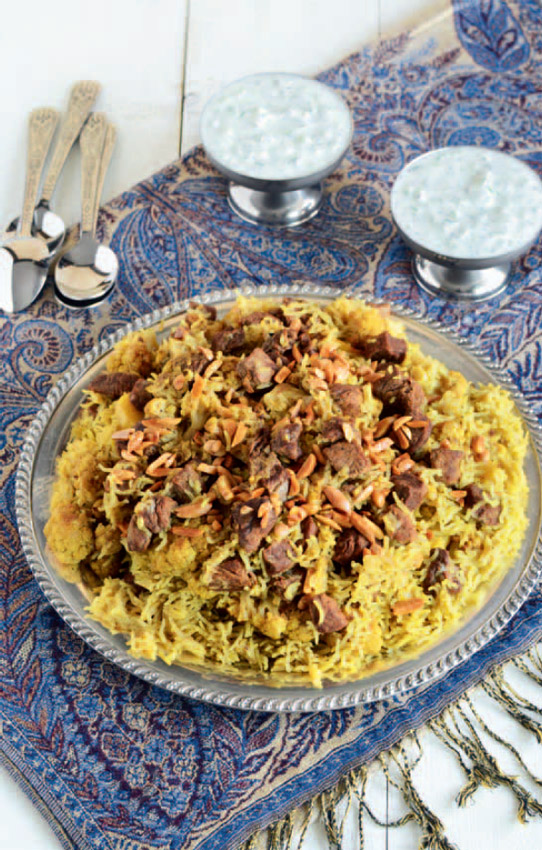Beef is eaten in the Middle East, but lamb is generally the preferred red meat; however, in the recipes in this book you can use beef and lamb interchangeably to suit your preferences. Along with the dishes in Chapter 7 (Chicken and Seafood), many recipes contained in this section are for more formal meals, the kinds of meals that are used for entertaining guests. For a guest whom you particularly like or want to show your generosity, you either buy several different kinds of meat and grill everything, see Lamb or Beef Kebab (Kebab wa Kufta)(page 112), or you make some kind of stuffed vegetables, see Stuffed Marrow Squash in Yogurt Sauce (Kousa Mahshi bil Leban)(page 104) and Stuffed Marrow Squash (Kousa Mahshi) (page 107). However, some of the recipes in this section are less formal, and are perfect for using up a small amount of leftover meat, such as Meat Sautéed with Leeks (Bellassia) (page 106) and Scrambled Eggs with Meat and Onion (Bayd bil Lahmeh wa Bussel) (page 105).
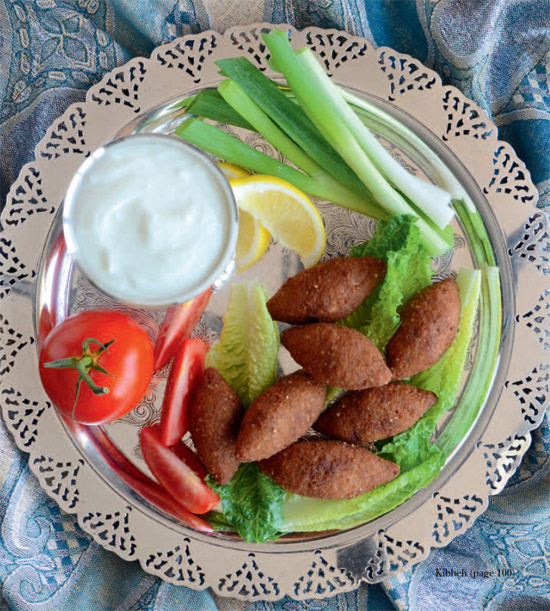
Kibbeh with Variations LAMB AND BULGUR WHEATA
Kibbeh is found all over the Middle East and there are dozens of different variations. It can be shaped into just about any form you can imagine and then fried, grilled, boiled, or baked. Some versions are stuffed and other recipes have accompanying sauces. Perhaps the most commonly known form of Kibbeh is fried; these fritters are filled with stuffing (typically meat) and are known by their signature shape: a slightly elongated sphere with pointed ends (like an American football or a torpedo). Because this dish is time-consuming and a bit more difficult to make than most, it’s what you make for guests you want to impress.
Fried Kibbeh may be difficult to shape at first, but as you practice you will get much faster and more adept at it. (i didn’t grow up making Kibbeh and I don’t make it very often, so when I do make it, I can always see which ones I made at the beginning of the batch and which ones I made later…you really will improve that quickly at making these!)
Note: Beef can be used instead of lamb in any Kibbeh recipe. The meat should be very lean (such as from the loin) with no tendons or sinew; also, it must be very fresh and very, very finely ground.

VARIATION 1
Fried Kibbeh
KIBBEH MEKLIYEH
Yields about 45 pieces
Preparation Time: 2 hours, 30 minutes
Cooking Time: 1 hour
1 lb (500 g) finely ground bulgur wheat
Water, to soak the bulgur
1 tablespoon salt
1 teaspoon ground cumin
1 teaspoon ground coriander
¼ teaspoon ground black pepper
1 onion, peeled and quartered
½ lb (250 g) lean lamb, very finely ground
4-6 tablespoons water, to moisten the dough
Oil, for deep-frying
Salad and/or plain yogurt (optional, for serving)
Filling
1½ tablespoons oil
One large onion, finely diced
¾ teaspoons salt, divided
¾ lb (350 g) lean lamb, very finely ground
½ teaspoon Syrian Spice Mix (page 29)
½ teaspoon ground cumin
½ teaspoon ground coriander
¼ teaspoon ground black pepper
2 tablespoons pine nuts
2 to make the filling, add the oil to a large skillet over medium heat; once hot, add the onion and ¼ teaspoon salt and fry until softened, about 7 minutes, stirring occasionally. Add the ground lamb, remaining ½ teaspoon salt, Syrian Spice Mix, cumin, coriander, and black pepper. Cook until browned, about 5 minutes, stirring occasionally and using a wooden spoon to break up the meat. Stir in the pine nuts and cook 3 minutes more, stirring occasionally. Taste and season with additional salt and pepper as desired; cool completely.
3 Pour the bulgur into the bottom of a large bowl and fill the rest of the bowl with tepid water; soak 15 minutes and then drain out the water.
4 Mix the bulgur with the salt, cumin, coriander, and black pepper. Grind the bulgur and onion in a meat grinder (fine grind), a stand mixer fitted with a food grinding attachment (fine grind), or in a heavy-duty food processor until it feels very soft (it takes 2 to 3 times using a meat grinder or stand mixer fitted with a food grinding attachment). Transfer the bulgur mixture to a large bowl and use your hands to knead in the meat; as you’re kneading, add water (about 4-6 tablespoons) so that the mixture comes together to form a dough.
5 to stuff the Kibbeh, have a bowl of room temperature water nearby for wetting your hands. Wet your hands, then scoop out 2 tablespoons of the bulgur mixture and shape it into an oval. Put a finger into one end, then while turning the oval with one hand, keep your finger from the other hand still so that it acts like a drill and the opening gets bigger. Stuff about 2 teaspoons of the meat filling into the opening, then wet your fingers and gently pinch the bulgur together to close the opening; shape both ends so they’re slightly pointed. Continue this way with the rest of the bulgur mixture and filling.
6 Fill a large, heavy-bottomed pot halfway full with oil; warm over medium-high heat until it reaches 350˚F (175˚C). Fry the Kibbeh in batches so the pot isn’t overcrowded; cook each batch until the Kibbeh is golden brown (about 4 to 6 minutes per batch). Transfer the cooked Kibbeh to a paper towel-lined plate to drain any excess oil.
7 Serve hot, warm, or room temperature with salad and/or plain yogurt, if desired.
VARIATION 2
Fried Kibbeh in Yogurt Sauce
KIBBEH LABANIYEH
Serves 8
Preparation Time: 2 hours, 30 minutes
Cooking Time: 1 hour, 15 minutes
1 batch Fried Kibbeh (above)
2 batches Yogurt Sauce, prepared with dried, crushed tarragon (see Meat-Stuffed Marrow Squash in Yogurt Sauce (Kousa Mahshi bil Leban) and its headnote (page 104)
Prepare the fried Kibbeh and add to the yogurt sauce, turn heat down to low, and cook until warm, about 3 minutes.
Forming the Kibbeh
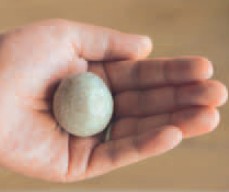
STEP 1: Scoop out two tablespoons of the bulgur mixture.
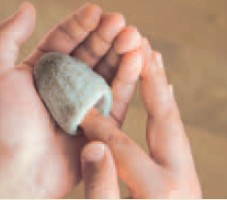
STEP 2: Shape the bulgur into an oval by rolling it between your hands; put a finger into one end, then while turning the oval with one hand, keep your finger from the other hand still so that it acts like a drill and the opening gets bigger.
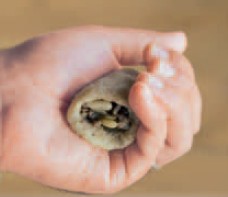
STEP 3: Stuff about 2 teaspoons of the meat filling into the opening, then wet your fingers and gently pinch the bulgur together to close the opening.
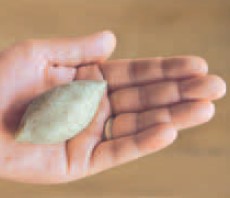
STEP 4: Shape both ends so they’re slightly pointed.
Baked Kibbeh Pies
KIBBEH BIL FURUN
Yields 2 pies (9 in/23 cm)
Preparation Time: 2 hours, 30 minutes
Cooking Time: 1 hour, 15 minutes
1 lb (500 g) finely ground bulgur wheat
Water, to soak the bulgur
1 tablespoon salt
1 teaspoon ground cumin
1 teaspoon ground coriander
¼ teaspoon ground black pepper
1 small onion, peeled and quartered
½ lb (250 g) lean lamb, finely ground
4-6 tablespoons water, to moisten the dough
Filling
1½ tablespoons canola oil
One large onion, finely diced
¾ teaspoon salt, divided
¾ lb (350 g) lean lamb, finely ground
½ teaspoon Syrian Spice Mix (page 29)
½ teaspoon cumin
½ teaspoon coriander
¼ teaspoon black pepper
2 tablespoons pine nuts
½ cup (125 ml) olive oil, divided
1 Prepare the Syrian Spice Mix
2 to make the filling, add the oil to a large skillet over medium heat; once hot, add the onion and ¼ teaspoon salt and fry until softened, about 7 minutes, stirring occasionally. Add the ground lamb, remaining ½ teaspoon salt, Syrian Spice Mix, cumin, coriander, and black pepper. Cook until browned, about 5 to 7 minutes, stirring occasionally and using a wooden spoon to break up the meat. Stir in the pine nuts and cook 3 minutes more, stirring occasionally. Taste and season with additional salt and pepper as desired, cool completely.
3 Pour the bulgur into the bottom of a large bowl and fill the rest of the bowl with tepid water; soak 15 minutes and then drain out the water.
4 Mix the bulgur with the salt, cumin, coriander, and black pepper. Grind the bulgur and onion in a meat grinder (fine grind), a stand mixer fitted with a food grinding attachment (fine grind), or in a heavy-duty food processor until it feels very soft (it takes 2 to 3 times using a meat grinder or stand mixer fitted with a food grinding attachment). Transfer the bulgur mixture to a large bowl and use your hands to knead in the meat; as you’re kneading, add water (4-6 tablespoons)so that the mixture comes together to form a dough.
5 Preheat oven to 400˚F (200˚C); brush 1 tablespoon of olive oil on the bottom and up the sides of 2 baking pans (9-inches/23 cm). Divide the bulgur mixture into 4 equal parts; roll each into a ball and flatten slightly into a disk. Roll each disk out between 2 pieces of parchment paper to a 9-inch (23 cm) circle.
6 Place 1 circle of dough into the bottom of each prepared pan; wet your hands and smooth the dough into an even layer in the bottom of the pan. Divide the filling between the 2 pans, spreading it out evenly, and leaving a ¼-inch (6 mm) rim all the way around. Place the remaining 2 dough circles on top of the filling in each pan; again, wet your hands and smooth the dough into an even layer, gently pressing it down.
7 Run a knife along the outer rim of the pan, and then score a decorative crisscross pattern on top. Drizzle 3 tablespoons olive oil on top of each pie. Bake until golden brown along the outer rim, about 30 to 40 minutes. Once cooked, if you want the top of the Kibbeh to have more color, you can broil it for a couple minutes.
VARIATION 4
Raw Kibbeh
KIBBEH NAYEH
Serves 6
Preparation Time: 35 minutes
Cooking Time: 0 minutes
½ lb (250 g) finely ground bulgur wheat
Water, to soak the bulgur
½ tablespoon salt
½ teaspoon ground cumin
½ teaspoon ground coriander
1/8 teaspoon ground black pepper
1 onion, peeled and quartered
½ cup shelled walnuts
½ lb (250 g) lean lamb, very finely ground
2 tablespoons pomegranate molasses
1-2 teaspoons dried red pepper flakes, plus more for garnish (optional)
Ice cold water, to moisten the dough (about 2 tablespoons)
2 tablespoons olive oil (for garnish)
1 sprig fresh parsley or mint (for garnish)
1 Pour the bulgur into the bottom of a large bowl and fill the rest of the bowl with tepid water; soak 15 minutes and then drain out the water.
2 Mix the bulgur with the salt, cumin, coriander, and black pepper. Grind the bulgur, onion, and walnut in a meat grinder (fine grind), a stand mixer fitted with a food grinding attachment (fine grind), or in a heavy-duty food processor until it feels very soft (it takes 2 to 3 times using a meat grinder or stand mixer fitted with a food grinding attachment).
3 transfer the bulgur mixture to a large bowl and use your hands to knead in the meat, pomegranate molasses, and dried red pepper flakes; as you’re kneading, add water (about 2 tablespoons) so that the mixture comes together to form a dough.
4 Shape the raw Kibbeh into small, finger-shaped pieces or spread it out in a shallow dish. Drizzle the olive oil on top and a sprinkle on the parsley or mint, and a little bit of dried red pepper flakes, if using. Serve immediately.
Meat and Vegetable Casserole with Pomegranate
KOWAJ
the first time I had this dish its flavor completely surprised me; I knew it would be good, but I had no idea it would be this good. it’s the pomegranate molasses.
Serves 6
Preparation Time: 20 minutes
Cooking Time: 1 hour, 20 minutes (1 hour of which is bake time)
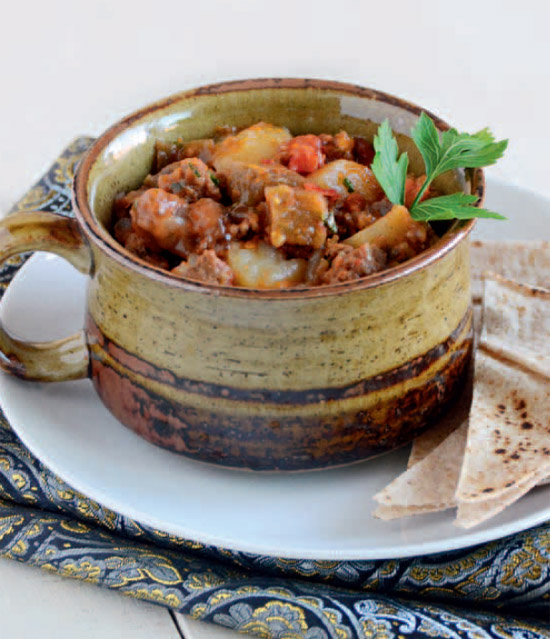
2 tablespoons olive oil
2 onions, diced
1 lb (500 g) lean ground lamb or beef
1¾ teaspoons salt, divided
¼ teaspoon freshly ground black pepper
3 cloves garlic, minced
1 lb (500 g) tomatoes, peeled and diced
1 lb (500 g) potatoes, peeled and cubed
1 lb (500 g) marrow squash, zucchini, or eggplant, cubed (peeled if using eggplant)
2 tablespoons tomato paste
2 tablespoons pomegranate molasses
½ cup (125 ml) water
¼ bunch fresh parsley leaves, minced
Flatbread or Rice with Toasted Vermicelli Noodles (page 58) (for serving)
1 Preheat the oven to 350˚F (175˚C).
2 heat the oil in a large skillet over medium heat; add the onion and sauté until starting to soften, about 5 minutes, stirring occasionally. Add the meat, 1 teaspoon salt, and the pepper; turn the heat up to high and cook until the meat is fully browned and the onion is tender, about 5 minutes, stirring occasionally and using a wooden spoon to break up the meat. Add the garlic and tomato and cook 5 minutes more.
3 transfer the meat mixture to a medium-sized casserole dish along with the potato and marrow squash (or zucchini or eggplant); stir to combine.
4 whisk together the tomato paste, pomegranate molasses, water, and remaining salt in a small bowl; drizzle on top of the casserole.
5 Cover the casserole dish and bake until the veggies are tender, about 1 hour to 1 hour, 15 minutes.
6 Stir in the fresh parsley leaves and serve with Arabic flatbread or Rice with toasted Vermicelli noodles.
Stuffed Squash with Yogurt Sauce
KOUSA MAHSHI BIL LABAN
This dish is a variant of Stuffed Marrow Squash (page 107), but instead of rice as part of the stuffing, it is served on the side. The tomato sauce is replaced with a creamy yogurt sauce that’s eaten like a soup or spooned on top of everything.
Leftovers are simple to reheat. Put the zucchini in a separate pot from the yogurt sauce. Add enough hot water to come just below the top of the zucchini, and bring to a simmer over low heat (do not stir); simmer until warm throughout, about three to five minutes. Meanwhile, bring the yogurt sauce up to a simmer in a heavy-bottomed saucepan over low heat, stirring constantly in one direction with a wooden spoon. If the yogurt sauce is too thick, you can add a splash of the water that the zucchini was reheated in to thin it out.
(Note: For a more flavorful yogurt sauce, add 1 tablespoon dried, crushed mint or 1 tablespoon dried, crushed tarragon, along with sautéed garlic. To sauté the garlic, add 1 tablespoon canola oil to a small pan over low heat; add 2 cloves of crushed garlic and cook until fragrant and light golden, about 2 to 3 minutes, stirring constantly. Stir the dried tarragon or mint into the garlic and add this mixture to the yogurt sauce before adding the zucchini.)
Serves 4 to 6
Preparation Time: 1 hour
Cooking Time: 1 hour, 15 minutes
Meat-Stuffed Marrow Squash
2 lb (1 kg) marrow squash or small zucchini, hollowed out (see Hollowing Out Vegetables to Stuff, page 12)
2 tablespoons oil, divided
2 large onions, diced
1 lb (500 g) lean ground lamb or beef
1 teaspoons salt
1 teaspoon Syrian Spice Mix (page 29)
¼ teaspoon freshly ground black pepper
3 tablespoons pine nuts
Rice with Toasted Vermicelli Noodles (page 58)
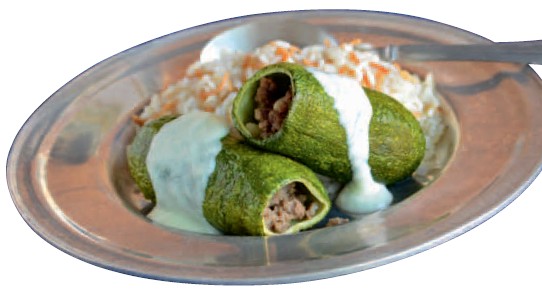
Yogurt Sauce
2 lb (1 kg or about 3¹⁄ 3 cups) plain yogurt, room temperature
1 large egg, lightly beaten
2 tablespoons cornstarch dissolved in 4 tablespoons cold water
½ teaspoon salt
1 Preheat oven to 375˚F (190˚C); line a baking sheet with parchment paper and brush ½ tablespoon of oil on the paper.
2 heat the remaining 1½ tablespoons of oil in a large skillet over medium heat; add the onion and sauté until it starts to soften, about 5 minutes, stirring occasionally. Add the ground meat, salt, Syrian Spice Mix, and black pepper; turn heat up to high and cook until the meat is fully browned and the onion is tender, about 5 minutes, stirring occasionally and using a wooden spoon to break up the meat. Stir in the pine nuts and cook 3 minutes more, stirring occasionally. Cool slightly.
3 Stuff the meat mixture into the hollowed out marrow squash/zucchini, packing firmly and leaving about ½ inch (1.25 cm) at the top of each. Transfer to the prepared baking sheet and roll to coat with the oil. Bake until the marrow squash/zucchini is tender and golden in places, about 40 minutes, flipping once halfway through, set aside. (Alternatively, these can be deep fried until golden.)
4 Make the Yogurt Sauce by combining the yogurt, egg, dissolved cornstarch, and remaining salt in a large, heavy-bottomed saucepan over medium heat. Bring to a boil while stirring constantly in one direction with a wooden spoon, then turn the heat down and simmer 2 minutes, continuing to stir constantly.
5 Add the zucchini to the Yogurt Sauce, bring to a simmer over low heat, and simmer uncovered 10 minutes. (if the sauce thickens too much add a splash of water.) to prevent the zucchini from breaking apart, do not stir (it’s better to swirl the pot if necessary). Remove the zucchini and strain the Yogurt Sauce to remove any lumps, if desired.
6 to serve, pour the Yogurt Sauce into individual bowls (to be eaten as soup or spooned on top of everything), arrange the zucchini on a platter, and serve alongside Rice with toasted Vermicelli noodles.
Scrambled Eggs with Meat and Onion
BAYD BIL LAHMEH WA BUSSEL
This dish is a great way to stretch a little bit of meat. Raw green onion (scallion) is tasty to eat alongside, and of course flat-bread is perfect for scooping it up.
Serves 4 as part of a maza platter or 2 as a meal
Preparation Time: 5 minutes
Cooking Time: 10 minutes
2 tablespoons oil
½ lb (250 g) lean ground beef or lamb
1 onion, diced
½ teaspoon salt
1/8 teaspoon freshly ground black pepper
4 large eggs, lightly beaten
1 sprig fresh parsley leaves, chopped (optional, for garnish)
1 Add the oil to a large nonstick skillet over moderately high heat. Add the meat and onion, and cook until the meat is browned and the onion is softened, about 5 to 7 minutes, stirring occasionally and using a wooden spoon to break up the meat. Stir in the salt and pepper.
2 turn heat down to medium and pour in the eggs. Let the eggs cook until slightly set, about 1 minute, then gently stir upward from the bottom so the uncooked eggs are exposed to the bottom of the pan; continue stirring like this until the eggs are set, about 1 to 2 minutes more.
3 Sprinkle the parsley on top, if using.
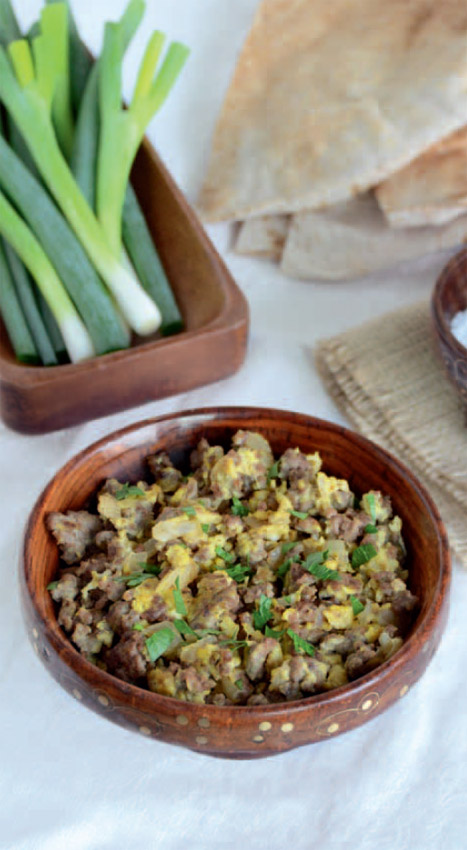
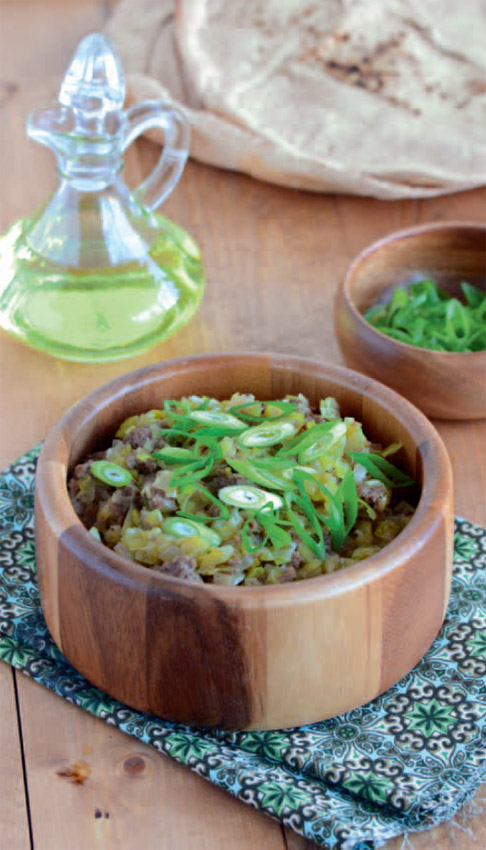
Meat Sautéed with Leeks BELLASSIA
With three different kinds of onion in this recipe, it really is an onion lover’s delight.
The leek is the star of this dish and has a pleasant, mild onion flavor without being overpowering. Traditionally, Bellassia is served as part of a maza platter with a variety of other dishes. Regardless of what else it’s served with, flatbread is always present since it’s used as a utensil to scoop up the mixture. Any leftovers will make a great omelet filling for the next day.
Serves 4 to 6 as part of a maza platter or 2 as a meal
Preparation Time: 10 minutes
Cooking Time: 20 minutes
4 tablespoons oil
½ lb (250 g) lean ground beef or lamb
1 onion, diced
2 lb (1 kg) leeks, white and light green parts only, rinsed and finely diced
½ teaspoon salt
¼ teaspoon freshly ground black pepper
1 green onion (scallion), white and green parts, thinly sliced on an angle (optional, for garnish)
1 Add the oil to a large skillet over high heat. Stir in the meat and diced onion, and cook until the meat is browned and the onion is softened, about 5 to 7 minutes, stirring occasionally and using a wooden spoon to break up the meat.
2 Add the leek, salt, and pepper and cook uncovered 5 minutes, then cover the skillet, turn heat down to medium, and cook until the leeks are soft, about 5 to 7 minutes more, stirring occasionally.
3 transfer to a serving dish. Sprinkle green onion on top, if using.
KOUSA MAHSHI
Like any stuffed dish, Stuffed Marrow Squash can be somewhat time-consuming to make. Hollowing out the vegetables is what takes the longest, but this is best done with a group of friends and a pot of coffee on a carefree afternoon.
To reheat, bring the tomato broth to a simmer and add the marrow squash or zucchini; heat until warm, about 15 minutes.
Serves 4 to 6
Preparation Time: 1 hour, 15 minutes
Cooking Time: 1 hour, 25 minutes
2 lb (2 kg) marrow squash or small zucchini, hollowed out (see Hollowing Out Vegetables to Stuff, page 12)
1 batch Lamb and Rice Stuffing (page 28)
1 tablespoon olive oil
1 small onion, finely diced
2 cloves garlic, crushed in a mortar and pestle
Three tomatoes, peeled and diced (with their juices)
3 tablespoons tomato paste
¾ teaspoon salt
¼ teaspoon freshly ground black pepper
2 chicken or beef-flavored soft bouillon cubes
2 bay leaves
3 tablespoons minced fresh parsley leaves
1 teaspoon dried mint
1 lemon, wedged (optional, for serving
Plain yogurt (optional, for serving)
1 Prepare the Lamb and Rice Stuffing.
2 heat the oil in a medium pot over medium heat; add the onion and cook until softened, about 5 to 7 minutes, stirring occasionally. Add the garlic and sauté 1 minute more, stirring constantly.
3 Add the tomato, tomato paste, salt, black pepper, bouillon cubes, bay leaves, fresh parsley, and enough water to fill the pot so that it is somewhere between 2/3 to ¾ of the way full (about 8 cups/1.75 liters). Heat the tomato broth over low heat until it comes to a simmer.
4 Stuff each marrow squash or zucchini shell with the Lamb & Rice Stuffing, packing the mixture down slightly so that when turned upside-down the mixture doesn’t fall out. Leave about ½ to ¾ inch (1.25 to 2 cm) at the top of each because the rice will expand when cooking.
5 Add the stuffed squash to the simmering tomato broth; cover the pot and bring back up to a simmer, then cook until the rice is fully done, about 1 hour. If the squash doesn’t all fit in the pot because there’s too much liquid, you can just ladle out some broth. (to check if the rice is fully cooked, remove a piece of squash and cut it in half.)
6 Serve the squash alongside the tomato broth to eat as soup or to spoon on top, along with fresh lemon to squeeze on top and yogurt, if using.


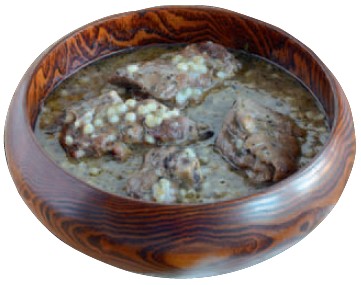
SHORABET SHAREEYEH
This hearty soup is perfect for a cold day. Oregano and mint are herbs that are part of the same family and really work together well in this dish. This soup thickens after standing; to reheat any leftovers, warm it on the stovetop, adding water as necessary.
Serves 4 to 6
Preparation Time: 10 minutes
Cooking Time: 2 hours, 5 minutes (1 hour, 45 minutes of which is simmer time)
2 tablespoons olive oil
2 lb (1 kg) bone-in lamb shoulder, cut into large pieces and patted dry
2 onions, diced
1½ teaspoons dried oregano ½ teaspoon Nine Spice Mix (page 29)
¼ teaspoon salt
2 bay leaves
2 chicken or beef-flavored soft bouillon cubes
7 cups (1.7 liters) water
½ cup (100 g) pearl barley
1½ teaspoons dried mint flakes
1 Prepare nine Spice Mix.
2 heat the oil in a medium pot with a lid, over moderately high heat; add half the lamb and brown, allowing it to sear on all sides, about 3 to 5 minutes. Transfer the seared lamb to a bowl; sear the rest of the lamb the same way and transfer it to the bowl with the rest of the lamb.
3 Add the onion to the pot the lamb was cooked in and sauté until wilted, about 3 minutes. Add the oregano, nine Spice Mix, salt, bay leaves, bouillon cubes, and water.
4 Bring to a boil over high heat, skimming off any foam on the surface. Turn heat down to simmer, cover the pot, and cook until the meat is tender, about 60 to 90 minutes, stirring occasionally. Add the barley and cook until tender, about 30 minutes, stirring occasionally.
5 turn off heat and stir in the mint; serve.
Lamb and Navy Bean Stew
FAJOOM
This soup is a classic example of Syrian cooking; it’s thick and rich, and heady with the aroma of spices.
Serves 6
Preparation Time: 10 minutes
Cooking Time: 1 hour, 20 minutes (1 hour of which is simmer time)
2 tablespoons clarified butter (or 1 tablespoon unsalted butter plus 1 tablespoon canola oil)
2 onions, diced
1 lb (500 g) boneless lamb shoulder or leg of lamb, trimmed of excess fat and cubed
2 cloves garlic, crushed in a mortar and pestle
2 teaspoons ground cumin
1 teaspoon Syrian Spice Mix (page 29)
½ teaspoon freshly ground black pepper
2 chicken or beef-flavored soft bouillon cubes
2 bay leaves
3 tablespoons tomato paste
4 cups (1 liter) water
Two 15 oz (425 g) cans navy beans, rinsed and drained
1 batch Rice with Toasted Vermicelli Noodles (page 58) (optional, for serving)

1 Prepare Syrian Spice Mix.
2 heat the clarified butter in a medium pot and place over medium heat; add the onion and cook 5 minutes, stirring occasionally. Turn the heat up to high, add the lamb, and cook until browned, about 3 to 5 minutes (do not stir until it’s browned on the first side). Add the garlic and cook 30 seconds, stirring constantly.
3 Stir in the cumin, Syrian Spice Mix, black pepper, bouillon cubes, bay leaves, tomato paste, and water. Bring to a boil and then cover the pot, leaving the lid slightly ajar; turn the heat down to simmer and cook until meat is tender, about 45 minutes to 1 hour, stirring occasionally. (if the stew starts to look too thick, fully cover the pot or add a splash of water.)
4 Add the beans and cook until heated through, about 3 to 5 minutes.
5 Serve alongside Rice with toasted Vermicelli noodles, if using.
SHAKREEYEH
If you didn’t grow up eating this soup, it really is an acquired taste. On the other hand, if you’ve eaten this soup all your life you’re likely to love it from a young age. (i can attest to this, as i’ve seen firsthand many mothers feeding this to their young ones. One mom told me, referring to her three-year-old daughter, “it’s all she’ll eat!”) this soup is creamy but very tangy; garlic accentuates the other flavors very well. It is frequently eaten the day after Ramadan, since yogurt is good for digestion.
Serves 6
Preparation Time: 5 minutes
Cooking Time: 1 hour, 30 minutes (1 hour of which is simmer time)
3 tablespoons oil, divided
1 lb (500 g) boneless lamb shoulder or leg of lamb, trimmed of excess fat and cubed
Water to cover the lamb (about 2½ cups/625 ml)
2 chicken or beef-flavored soft bouillon cubes
¼ teaspoon salt
2 bay leaves
2 tablespoons cornstarch, dissolved in 2 tablespoons cold water
2 lb (1 kg) plain yogurt, room temperature
3 cloves garlic, crushed
¼ teaspoon salt
1 batch Rice with Toasted Vermicelli Noodles (page 58) (optional, for serving)
1 Prepare Rice with toasted Vermicelli noodles, if using.
2 heat 2 tablespoons of oil in a medium, heavy-bottomed pot over high heat; add the lamb and cook until browned, about 3 to 5 minutes (do not stir until it’s browned on the first side).
3 Add just enough water to cover, then add the bouillon cubes, salt, and bay leaves. Bring it up to a boil, then put the lid on, turn the head down, and simmer until the meat is tender, about 45 minutes to 1 hour.
4 Mix the cornstarch and cold water in a small bowl; add the cornstarch/water slurry and the yogurt to the pot with the meat. Bring to a simmer over medium-low heat while stirring constantly in one direction with a wooden spoon; simmer 2 minutes, continuing to stir constantly.
5 heat the remaining 1 tablespoon oil in a small pan over low heat; add the garlic, salt, and cook until fragrant and light golden, about 2 to 3 minutes, stirring constantly.
6 Add the garlic to the soup and serve with Rice with toasted Vermicelli noodles (Roz bil Shariya), if using.
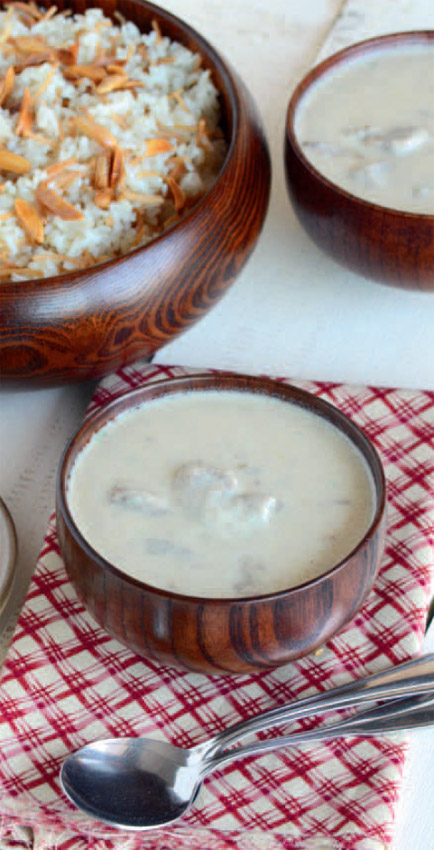

M’NEZALIT ZAHARA
This dish sounds a little unusual, but it tastes surprisingly fantastic. The pomegranate molasses gives it a wonderfully complex sweet/tart flavor. Serve it spooned over Rice with toasted Vermicelli noodles (Roz bil Shariya) (page 58)
to make it a full meal.
Serves 4 to 6
Preparation Time: 15 minutes
Cooking Time: 1 hour
4 tablespoons olive oil, divided
1 large onion, diced
1 lb (500 g) boneless lamb, trimmed of excess fat and cubed
4 cloves garlic, crushed in a mortar and pestle
3 tomatoes, diced
2 tablespoons tomato paste
2 tablespoons pomegranate molasses
1 cup (250 ml) water
1 chicken or beef-flavored soft bouillon cube
¾ teaspoon salt, divided
¼ teaspoon freshly ground black pepper or 1 teaspoon Meat Spice Mix (page 29)
1 large head cauliflower, cut into florets
½ bunch coriander leaves (cilantro), minced
1 batch Rice with Toasted Vermicelli Noodles (page 58) (for serving)
1 Prepare Rice with toasted Vermicelli noodles.
2 heat 2 tablespoons oil in a medium lidded saucepan over high heat; add the onion and cook 5 minutes, stirring occasionally. Turn the heat up to high, add the lamb and cook until browned, about 3 minutes. Add the garlic, tomatoes, tomato paste, and pomegranate molasses, and cook 2 minutes, stirring constantly. Add the water, bouillon cube, ½ teaspoon of salt, and black pepper. Bring it to a boil; turn the heat down to simmer, cover the saucepan, and cook until the meat is tender, about 30 to 40 minutes, stirring occasionally.
3 Preheat oven to 400˚F (200˚C); line a large baking sheet with parchment paper or a silpat liner. Toss the cauliflower with the remaining 2 tablespoons oil and the remaining ¼ teaspoon salt in a large bowl. Spread the cauliflower out on the prepared baking sheet and roast until golden brown in spots, about 40 minutes, stirring once halfway through.
4 when the meat is tender, add the roasted cauliflower and cilantro to the meat sauce and cook (uncovered) until the cauliflower is warmed, about 3 to 5 minutes.
5 Serve alongside Rice with toasted Vermicelli noodles.
Lamb or Beef Kebabs KEBAB WA KUFTA
Kebab is meat that is flavored with onion, parsley, and spices. If this mixture is cooked in a tray (instead of in a frying pan or on a grill), it’s referred to as kufta, although the meat mixture used is the same; prepared this way, it is usually thought of as meatloaf or meatballs. Simple as it sounds, there are an endless number of different variations on this one meat mixture. My father-in-law’s favorite version of this dish is the Baked with Potato and tomato version and I learned this variant from him. Other tasty variations include a tangy tahini or yogurt-based sauce to top kufta that is either spread in a tray or shaped into round or oblong meatballs and then baked. In general, if you’re making kebab use semi-lean meat and if you’re making kufta, use lean.
Each variation serves 3 to 4
Skewered Grilled Kebabs
Preparation Time: 15 minutes
Cooking Time: 10 minutes
1 lb (500 g) semi-lean or lean ground lamb or beef
1 small onion, grated
¼ bunch fresh parsley leaves, minced
1 teaspoon salt
1 teaspoon Seven Spice Mix (page 29)
1/8 teaspoon fresh ground black pepper
1 use your hands to combine all ingredients in a large bowl.
2 Fill a small bowl with water for wetting your hands in between shaping the kebabs. Wet your hands and roll a small handful of the meat mixture into a ball (about the size of an egg), then slide it onto a metal skewer. Flatten the ball so the meat spreads out on the skewer, and repeat this process until all the meat is skewered.
3 Grill until fully cooked, about 8 to 10 minutes, flipping once halfway through.
VARIATION 1
Pan-Fried Kebabs
Preparation Time: 10 minutes
Cooking Time: 10 minutes
1 batch Kebab Meat Mixture
1 tablespoon olive oil
1 Shape the meat into 8 equal patties.
2 heat the oil in a large nonstick skillet over medium to moderately-high heat.
3 Add the patties and cook until browned outside and cooked through, about 8 to 10 minutes, flipping once.
4 Serve immediately, with Cucumber Yogurt Salad (Leban bil Khiear) (page 43), Middle Eastern Salad (Salata) (page 47), and/or Mixed white & Yellow Rice (page 61), if desired.
VARIATION 2
Baked Kebabs with Potato and Tomato KUFTA BIL SAYNIEHA
Preparation Time: 15 minutes
Cooking Time: 45 minutes
1 batch Kebab Meat Mixture
3-4 potatoes, peeled and sliced
3-4 tomatoes, sliced
¾ teaspoon salt
¼ teaspoon freshly ground black pepper
1 tablespoon olive oil
1 tablespoon fresh lemon juice
2 tablespoons minced fresh parsley leaves (optional, for garnish)
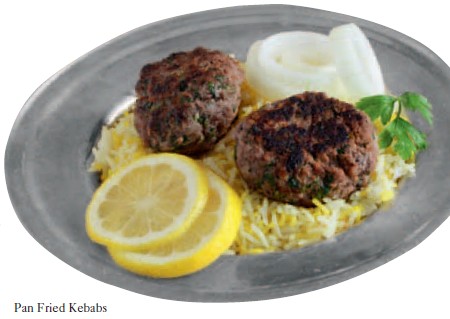
1 Preheat oven to 400˚F (200˚C). Get out a 9 to 10-inch (23 to 25 cm) round baking pan (or a 9-inch/23 cm square baking pan).
2 Put the potato slices into a medium saucepan and add enough cold water to cover them by about 1 inch (2.5 cm). Bring to a boil over high heat, then turn the heat down slightly and simmer until fork-tender, about 5 to 7 minutes; drain.
3 Press the meat evenly into the bottom of the pan. Arrange the potato in an even layer on top of the meat (they should all fit with minimal overlapping), then sprinkle on ½ teaspoon salt and 1/8 teaspoon black pepper. Arrange the tomato in an even layer on top of the potato, then sprinkle on the remaining ¼ teaspoon salt and 1/8 teaspoon black pepper. Drizzle the olive oil and lemon juice on top.
4 Cover the dish bake until the meat is fully cooked, about 30 minutes, uncovering the dish about halfway through cooking so some of the liquid can evaporate. Once cooked, if you want to brown the top in spots, you can place it briefly under the broiler.
5 Cool slightly before cutting and serving; sprinkle parsley on top, if using.
Meatballs with Potato in Tomato Sauce KEBAB HINDI
This is another variation of Lamb or Beef Kebab (page 112). It’s one of my mother-in-law’s specialties and it always feels like a special treat when she makes it. Funnily enough, the name literally means “indian Kebab,” although you’d be hard pressed to find anything indian about it, or to find someone who can explain where the name comes from.
Serves 4 to 6
Preparation Time: 25 minutes
Cooking Time: 1 hour, 5 minutes (45 minutes of which is bake time)

1 batch uncooked Lamb or Beef Kebab (opposite page)
3 tablespoons clarified butter (or 1½ tablespoons canola oil and 1½ tablespoons butter)
3-4 onions, chopped
3-4 tomatoes, chopped
1 teaspoon salt
½ teaspoon Syrian Spice Mix (page 29)
1/8 teaspoon freshly ground black pepper
4 tablespoons tomato paste
2 cups (500 ml) water
3-4 potatoes, peeled and cut into wedges or cubes
1 batch Rice with Toasted Vermicelli Noodles (optional) (page 58)
1 Prepare Lamb or Beef Kebab, Syrian Rice Mix, and Rice with toasted Vermicelli noodles.
2 Fill a small bowl with water and keep it next to you so you can wet your hands while shaping the meat. Grab a small handful of the meat mixture (about 2 tablespoons) and shape it into an oblong finger-shaped piece about 2 inches (5 cm) long; repeat this process with the rest of the meat.
3 heat the clarified butter in a large skillet over moderately-high heat; add the meatballs in a single layer and cook until browned, about 2 to 3 minutes per side, flipping once. Transfer to a plate and set aside. Preheat the oven to 350˚F (175˚C).
4 Add the onion to the skillet the meat was cooked in, and cook over medium heat until starting to soften, about 5 to 7 minutes, stirring occasionally. Stir in the tomato, salt, Syrian Spice Mix, and black pepper; cook 5 minutes. Add the tomato paste and water, turn heat up to high, and bring up to a boil; cook 5 minutes.
5 transfer the tomato sauce, meatballs, and potato to a medium-sized casserole dish; cover the dish and bake until the meat is fully cooked and the potato is tender, about 45 minutes.
6 Serve with Rice with toasted Vermicelli noodles, if using.

Upside-Down Rice Casserole MAQLUBA
Serves 6-8
Preparation Time: 1 hour, 30 minutes
Cooking Time: 2 hours, 20 minutes (1 hour of which is simmer time for the meat)
1 lb (500 g) eggplant
1½ teaspoons salt, divided
Oil, for shallow frying
1 head cauliflower, cut into florets
3-4 potatoes, peeled and sliced
½ cup (125 ml) plus 1 tablespoon olive oil, divided
1 onion, diced
1 lb (500 g) boneless lamb, trimmed of excess fat and cubed
1½ teaspoons Nine Spice Mix (page 29), divided
½ teaspoon freshly ground black pepper, divided
¼ teaspoon ground cinnamon
2 chicken or beef-flavored soft bouillon cubes
4 cups (1 liter) water
1 teaspoon ground cumin
½ teaspoon ground coriander
½ teaspoon ground turmeric
2 cups (425 g) uncooked basmati rice
4 tablespoons blanched almonds or pine nuts
Cucumber Yogurt Salad (page 43) or plain yogurt (optional, for serving)
After making Maqluba one day, my mother-in-law told me that Middle Eastern women spend way too much time in the kitchen. I laughed, because I had just seen how much work went into this one dish! the good thing about Maqluba is that even though it’s time consuming to make, it isn’t difficult; and better still, it can be broken down into steps and portions of it can be made up to a couple days in advance.
When I make Maqluba, I cook the cauliflower and potato two days in advance; the day before, I make the eggplant, meat, and the Cucumber Yogurt Salad (page 43) that is served with the casserole. That way, when it comes time to actually make the dish i’m not so overwhelmed.
This is a traditional Palestinian dish that’s enjoyed throughout the Levant. Of course there are as many different variations of this dish as there are families who make it. Some include tomatoes, green peppers, or thick-sliced rings of onion; others leave out potato or cauliflower. Some make it with chicken or beef instead of lamb.
Toasted nuts on top aren’t essential to this dish the way they are to a few other pilafs, but they are a tasty addition. In the Middle East, nuts are generally a relatively expensive item, so adding them to any dish is thought of as a nice way to honor your guests.
1 Prepare nine Spice Mix and Cucumber Yogurt Salad.
2 Fully or partially peel the eggplant if desired. (to partially peel it, peel one strip off down the length of the vegetable, then leave the strip next to it on and peel the next strip off, and so on). Slice into ½-inch (1.25-cm) thick slices crosswise.
3 Sprinkle 1 teaspoon salt on both sides of each slice of eggplant and transfer to a colander; put the colander in the sink and let it sit for 30 minutes (while the eggplant drains, prepare the cauliflower and potato). Rinse the eggplant under running water, then gently wring out any excess water and pat dry.
4 Coat the bottom of a large skillet over moderately high heat with oil. Fry the eggplant in batches (so the pan isn’t overcrowded) until golden brown, about 2 to 4 minutes per side. (You can add more oil to the pan if necessary.) transfer the cooked eggplant to a paper towel-lined plate to drain any excess oil.
5 Preheat oven to 400˚F (200˚C); line 2 large baking sheets with parchment paper or silpat liners.
6 toss the cauliflower florets with 2 tablespoons of olive oil and 1/8 teaspoon salt; transfer to one of the prepared baking sheets. Toss the potato slices with 2 tablespoons of olive oil and 1/8 teaspoon salt; transfer to the other prepared baking sheet. Roast the veggies until they’re tender and golden brown in places (about 40 minutes for the cauliflower and 30 minutes for the potato), flipping halfway through cooking.
7 heat 2 tablespoons olive oil in a medium pot over medium heat; add the onion and cook 5 minutes, stirring occasionally. Turn the heat to high, add the lamb, and cook until browned, about 3 to 5 minutes (do not stir until it’s browned on the first side).
8 Stir in 1 teaspoon of the nine Spice Mix, ¼ teaspoon of the black pepper, cinnamon, bouillon cubes, and water. Bring to a boil and then cover the pot; turn the heat down to simmer and cook until the meat is tender, about 45 minutes to 1 hour, stirring occasionally. Use a slotted spoon to transfer the meat to a bowl; set the meat aside and reserve the liquid.
9 Soak the rice in tepid water for 15 minutes; drain. Stir together the rice, remaining ¼ teaspoon salt, remaining ½ teaspoon nine Spice Mix, remaining ¼ teaspoon black pepper, cumin, coriander, and turmeric.
10 to layer the casserole, drizzle 1 tablespoon of olive oil on the bottom of a medium, thick-bottomed lidded saucepan. Sprinkle 2 tablespoons of rice across the bottom of the saucepan, arrange the meat on top, arrange the cauliflower on top of the meat, arrange the eggplant on top of the cauliflower, and then arrange the potato on top of the cauliflower; press the layers down gently with your hands (spread each layer as evenly as possible). Add the rest of the rice on top.
11 Bring the reserved liquid that the meat was cooked in to a boil (you can strain out the onions first if you want, but it isn’t necessary) and put half a kettle of water on to boil in case you need it. Add the meat liquid so that the rice is just covered with liquid, about 4 cups (1 liter); if the meat liquid isn’t enough, use boiling water.
12 Bring the casserole to a boil over moderately-high heat, then cover the pot, turn the heat down to very low, and simmer until the rice is tender, about 12 to 15 minutes, adding a splash of water if necessary.
13 heat the remaining 2 tablespoons of olive oil in a small skillet over medium heat. Add the nuts and cook until golden brown, about 1 to 2 minutes, stirring constantly. Transfer to a small bowl and set aside.
14 Once cooked, let the rice sit with the lid on for 15 minutes, then remove the lid and place a large platter on top of the pot. Carefully invert the pot and let it sit like this for 2 minutes, then tap the bottom of the pot and gently remove it.
15 Sprinkle the nuts on top and serve with Cucumber Yogurt Salad or plain yogurt.
